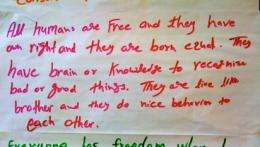Looking beyond English

In fall 2008, Daniel Ginsberg, an English as a Second Language teacher at a public high school in Malden, Mass., approached MIT professor Wayne O’Neil asking about incorporating linguistics into his curriculum to allow students to compare and contrast English with their native languages. O’Neil’s answer? Such a curriculum doesn’t exist for ESL students — but he’d be happy to help design one.
O’Neil, an MIT linguist who has been an advocate of linguistics education in secondary schools since the 1960s, has had plenty of experience developing curricula for both English and science classrooms. But he had never heard of an attempt to introduce linguistics to an ESL classroom — where students’ language backgrounds can be highly varied — so as to help them develop an English vocabulary for talking about language.
In Ginsberg’s class, students’ home languages included Cantonese, French, Haitian Creole, Hindi, Mandarin, Punjabi, Spanish and Tibetan — just a fraction of the 67 languages represented in the schools of Malden, just north of Boston. O’Neil worked with Ginsberg as well as his long-time collaborator, Wheelock College associate professor Maya Honda, to develop lessons plans that would take into account the ESL students’ abilities and needs. By teaching the scientific study of language, the three hoped to tap into the rich linguistic resources represented in the classroom to show students “just how valuable their language skills really are,” O’Neil says.
In a paper appearing in the of the journal Language and Linguistics Compass, Ginsberg, Honda and O’Neil outline the theory, practice and impact of their pedagogical approach.
The science of language
O’Neil is quick to emphasize that the study of linguistics is very different from the grammar traditionally taught in English classrooms. Rather than prescription — i.e., set rules to be learned and followed — linguistic inquiry follows the scientific process of gathering and analyzing data, formulating hypotheses, and testing and revising those hypotheses.
According to Ginsberg, introducing linguistics methods into an ESL classroom is interesting because “the primary data is intuitions that students have in their heads.” He says, “In linguistics, if you’re starting with native-speaker intuitions, you can start people at a fairly young age asking fairly sophisticated questions.”
The Malden students worked collaboratively on problem sets designed by O’Neil, Ginsberg and Honda, and later, on data provided by their classmates themselves. The material proved engaging, as students were drawn into exploring the similarities and differences between languages.
“We tried to steer students away from purely ‘right’ and ‘wrong’ answers, and had them looking for answers scientifically, in the data,” O’Neil says.
‘Do you have –s?’
The curriculum developed for the Malden class included four main modules: noun pluralization, language acquisition, writing systems and translation.
In the unit on noun pluralization, students were asked to reflect on how their native language expresses the concept of “more than one” and compare it with English and other students’ languages. In English, the regular plural is formed by adding the suffix –s to a noun. As O’Neil tells it, after discovering that regular plurals were formed in much the same way in both French and Spanish, one student raised her hand following a presentation on Hindi pluralization and said, “I have a question. Do you have –s?” The Hindi speaker replied, “No, my language is different.”
A unit on writing systems stemmed from student interest following presentations by the Chinese-, Hindi- and Tibetan-speaking students. Many students were surprised to learn that not all languages have a writing system, and that some, like Chinese, use symbols based on units of meaning rather than sound.
The final unit had students translate Article 1 of the United Nations’ Universal Declaration of Human Rights from their native language into English, demonstrating the nuances and subjectivity of translation. “A lot of ESL students are in a position of having to translate for their parents, which can be difficult,” O’Neil says. Because they were already familiar with the challenges of translation, when it came time for this exercise, “they really got into it.”
‘What they didn’t know they knew’
Linguistics is rarely taught in high schools — never mind in ESL classrooms, where differences in students’ native languages and English abilities can often pose additional challenges. But Howard Williams, an applied linguist and ESL specialist at the Teachers College of Columbia University who was unaffiliated with the work, says the idea is “novel, and perfectly sensible.” He believes the project has the potential to “be a real spark” in the field, and the main hurdle will be giving teachers adequate preparation to implement such a curriculum.
According to O’Neil, Honda and Ginsberg, teaching linguistics in the ESL context has an important added benefit: It is a way to empower students whose home languages are often actively pushed aside in English-only school environments.
“One of the greatest affective benefits of using students’ home languages as classroom content is that it authentically puts students in the role of expert,” the team writes in the paper. O’Neil adds, “It is empowering to have an adult say, ‘I don’t know how your language works; please teach me.’”
In this approach, O’Neil says, students tap into “what they didn’t know they knew” about both their native language and language in general.
By showing students that their bilingualism is an asset, not a hindrance, in the scientific study of language as well as more generally, O’Neil and his colleagues are hoping to contribute to the creation of a new generation of linguists — or at least, young people who are able to engage in critical inquiry to better understand the world around them.
This story is republished courtesy of MIT News (), a popular site that covers news about MIT research, innovation and teaching.
Provided by Massachusetts Institute of Technology


















